-
Car Reviews
- Car News
-
Car Comparisons
Latest comparisons
- Chasing Deals
Volkswagen says the Touareg is a luxury SUV – a claim borne out by the parts this model shares with premium vehicles like the Porsche Cayenne and Audi Q7. And now, there’s a new Wolfsburg trim at the top of the Touareg tree.
The 2021 Volkswagen Touareg Wolfsburg is VW’s most luxurious product, and also its most expensive. While the third-generation Touareg range launched in 2019 with a single variant, the lineup swelled to six this year before the limited-edition V8 310TDI R-Line sold out in autumn.
The culling of the out-of-production bent-eight installs the new V6-powered 210TDI Wolfsburg at the top of the Touareg range, priced at a heady-for-VW $119,990 before on-road costs – though that’s a discount compared to the $136,490 charged for the previous V8.
Next year, the crown may shift for a third time as Volkswagen works to secure the plug-in hybrid petrol V6 Touareg R for Australia.
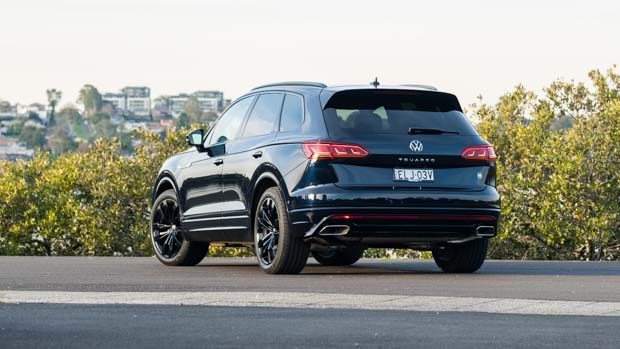
No matter which variant is king, though, the pertinent question is whether the Touareg convinces as a true luxury vehicle. The largest Volkswagen shares a lot of its parts with other luxury vehicles that also sit atop the Volkswagen Group’s longitudinal MLB platform – from Audi’s sedans to Lamborghini’s Urus SUV.
Add to that a suite of torquey diesel engines that make the Touareg perfect for towing, and – while it’s not as eye-catching as competitors – the elegant design communicates a quiet confidence that manifests in how this large SUV drives.
Perhaps the Touareg’s most natural competitor is the Volvo XC90. Like the VW, the Swede is a more pragmatic choice than blingy Germans like the Mercedes-Benz GLE 400d ($124,035) and BMW X5 30d ($121,900).
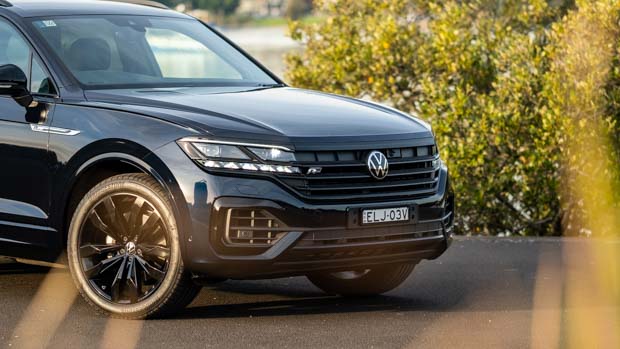
Pragmatic it may be with its restrained exterior styling and uncluttered interior, but the Touareg certainly isn’t cheap. The Touareg’s Audi sibling, the Q7 50 TDI S Line, costs a mere $1,310 more ($121,300 plus on-roads) with ostensibly identical specification, underpinnings and engine as this Wolfsburg edition. Audi even throws in a sunroof for that price; Volkswagen will sting you an extra $3,000 on top.
That’s not to say that this Touareg Wolfsburg is sparse on spec. You’ll notice the coat of arms from the region Volkswagen hails from as the identifier on the power-operated tailgate. The Touareg also scores standard 21-inch alloy wheels, air suspension, 15-inch touchscreen, ambient lighting and everything else you’d expect of a luxury SUV.
Of course, you don’t have to go so far up the range. The Touareg starts at $81,490 with 170TDI. The 210TDI R Line, on which the Wolfsburg specification is based, costs $108,990 plus on-roads. But neither of those variants get the sinister blacked-out grille and wheels.
The Touareg hasn’t always been so pragmatically-specified. Some might remember the wild V10 diesel that VW stuck under the bonnet in the first-generation car, for example, while Audi ran a V12 in the Q7. However, both cars have matured as time has gone on, and after this year’s final V8 flourish, the Touareg has been distinctly rationalised.

Until the plug-in hybrid Touareg R is confirmed, the sole engine used in the Australian Touareg lineup is a venerable three-litre, single-turbo V6 diesel engine offered in various states of tune.
The 210TDI motor is the gruntiest on offer, producing 210kW of power and 600Nm of torque. Those ample outputs make the Touareg almost unflappable, with bags of torque in reserve at all times. The Touareg also boasts sway control and a neat 360-degree camera with a tow hitch view to make the linking up a trailer hassle-free.
To deal with the substantial engine muscle, the Touareg has an eight-speed torque converter automatic rather than one of Volkswagen’s well-known dual-clutch autos. This ZF-sourced unit is immaculately tuned. The Touareg uses its prodigious torque to schmooze about in low gears and knows where the most grunt is for bouts of acceleration. You can take manual control (via slightly apologetic wheel-mounted paddles), and the transmission obeys well enough.
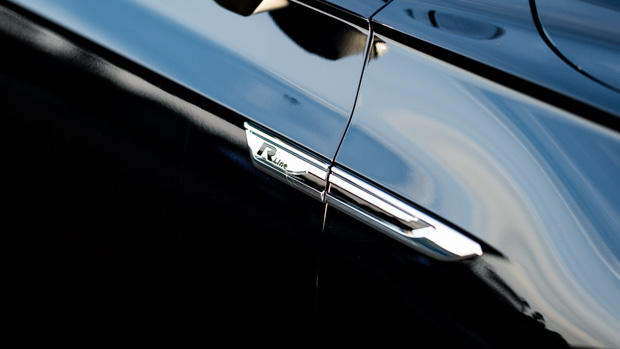
The suite of drive modes are helpful in selecting how you want to make progress in the Touareg. They affect the throttle and steering response, gearbox logic and suspension settings. The large SUV is appropriately plush in’ comfort’, if a little wayward at highway speeds. Swapping into ‘normal’ is wise for open roads.
With the big SUV locked in ‘sport’ mode, the Touareg sharpens right up. The air suspension hunkers down, stiffens up and works with the active roll stabilisation (powered by a 48-volt MHEV system) to quell an alarming amount of body movement. Add to that an adept rear-wheel-steer system and crazy sharp steering response, and the Touareg shrinks around the driver convincingly – certainly more so than an Audi Q7.
Naturally, the Touareg is AWD, though the 21-inch alloys hurt its ultimate ability. Still, the composure and grip the Touareg generates away from the blacktop sometimes make you forget that the tyres are gripping dirt, not tar. It makes touring stress-free.
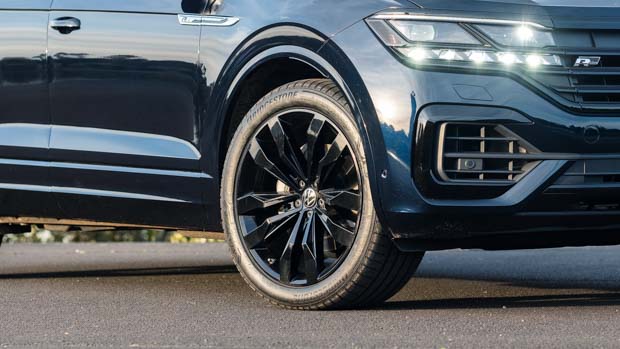
Further adding to the Touareg’s loping character is the air suspension, which manages to strike a near-perfect balance of plushness and control, though not everything is rosy. The 21-inch alloy wheels and Bridgestone Alenza tyres occasionally thump through sharp-edged bumps and break the otherwise serene Touareg experience.
This phenomenon was pronounced on dirt roads where sharp-edged rocks at low speed were the biggest culprits. The Touareg does display bank-vault qualities, though, with road and wind noise suppressed to a whisper. Even on gravel roads with all-four tyres looking for grip, very little noise made it through into the cabin above the smooth tick of the diesel V6.
That said, the now defunct Touareg Adventure variant combined the R-Line’s air suspension with smaller 19-inch alloys and made that car the pick of the range for long-range comfort.
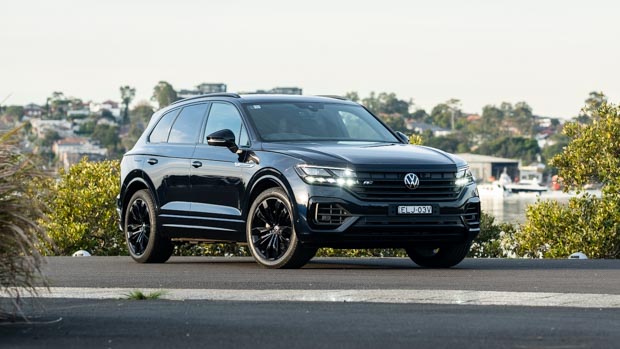
Unfortunately, the Wolfsburg’s cabin fit and finish left a little to be desired when those big wheels struck low-speed urban potholes. The shock of this results in creaking from the plastic trim on the dash, especially around the infotainment screen.
Turn up the smashing Dynaudio stereo and these noises fade into the background. Still, audible creaks in the cabin of a 1,800km old car justify that this generation of Touareg is not as immaculately built as the last.
Volkswagen outfits the Touareg Wolfsburg with its flagship travel assist program which gets the all-speed adaptive cruise control working with the lane-trace assist system. The idea is seamless highway driving, but the slightly awkward wheel-mounted controls and inaccurate speed control did not inspire confidence.
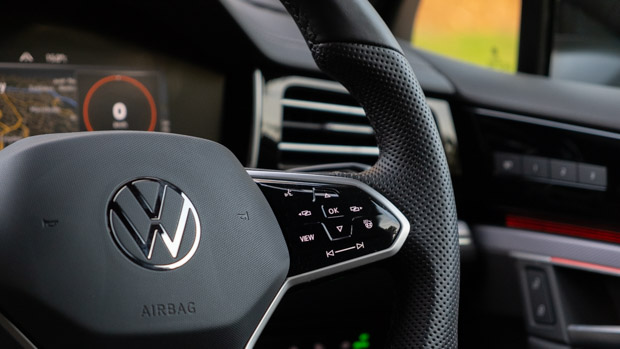
Further, to adjust simple settings like follow distance for the adaptive cruise, level of lane keep intervention and AEB sensitivity, you need to navigate through four menu layers in the central touchscreen. That convoluted interface left us wishing for simple shortcut buttons on the wheel.
What is impressive is the fitment of a full suite of safety equipment. The Touareg scored five stars when tested by ANCAP in 2019 and features frontal AEB with pedestrian and cyclist detection, front and rear cross-traffic alert, front and rear parking sensors.
The Touareg’s cabin impresses with its neatness and minimalism, especially with the Innovision cockpit (standard on the Wolfsburg) which is clearly how VW intended the dash to look, with a massive 15-inch touchscreen filling the dash perfectly. The more affordable Touareg variants like the 210TDI Elegance make do with a 9.2-inch touchscreen as standard.

You can option the big screen on any grade, but it will cost you an equally sizable sum of $8,000. Is it worth it? We think so. The graphics are outstanding. You can even select one of four analogue clock faces to be crisply rendered on the home screen next to a little 3D Touareg – it’s the little things – and in full-screen the maps are downright cartographic.
As good as the screen is, it brings me to the infotainment system’s quirks. By ditching physical shortcut buttons, it crowds the user interfaces with layers of menus. For instance, to switch on the recycle function for the AC, you need to select the air con from the bottom of the main screen, then locate the button and press it. The touch targets are large and easy to hit, but the interface falls short of user-friendly.
None of these complaints alone is enough to dismiss the Touareg. I’m sure you would grow accustomed to the quirks during a longer ownership term, but the learning curve is steeper than the best in the class like BMW, Audi and Mercedes systems.
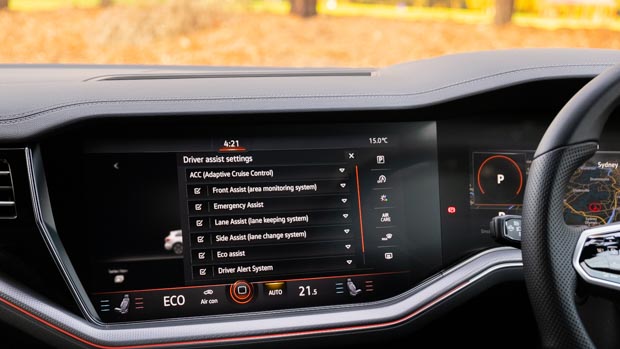
Still, there are plenty of things to love about the Touareg, including the 12.3-inch digital instrument cluster that integrates with a stellar navigation system. You also score a head-up display. All this adds up to a car that makes it easy to follow directions while staying aware of your surroundings.
Down below the massive touchscreen, Volkswagen hides a wireless charging pad in a covered storage cubby. Unfortunately, the Touareg does not have wireless Apple CarPlay or Android Auto capability, but there are plenty of USB points to connect your phone.
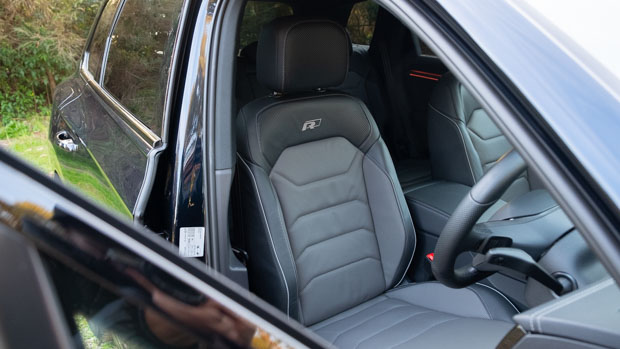
The centre console houses dual cup holders and neat space for a key. The leather-appointed centre armrest opens up to a deep felt-lined cubby with an extra USB port and the door bins are easily big enough for 1.5L bottles.
Most places you touch are appointed in high quality, squidgy materials though if you go searching below the beltline, you’ll find some scratchy plastics – it’s not leather smothered like a Genesis GV80. It’s around these hard plastics where the aforementioned creaks seemed to spring from. Further, we’d appreciate an option to ditch the Wolfsburg’s uninspiring piano black trim for warmer wood.
Volkswagen kicks back hard with fantastic seats appointed in the marque’s premium black ‘Savona’ leather. There is plenty of electric adjustment for position, lumbar and bolster inflation, heating and ventilation. There’s even uber-luxe massage functionality.
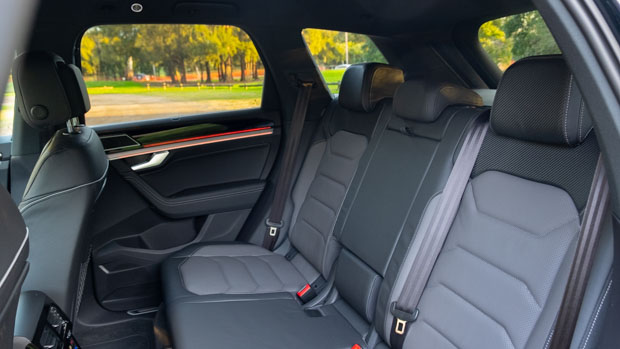
Despite its vast dimensions, the Touareg is only equipped to seat five, which may be reason enough to look elsewhere. However, there are some great points – the Wolfsburg scores dark privacy glass and window blinds in the second row which is fantastic if you have sleepy kids but otherwise makes for a dark space to sit. There are even separate climate zones for each back passenger, vents, a heated bench and a flip-out panel with two USB-C charging ports.
Space is ample in the back seat. Even at six-foot-two, I had plenty of head and kneeroom. The adjustable backrest and split-sliding bench mean you’ll be able to strike a balance between passenger comfort and cargo space to suit most situations. If you’re set on a seven-seater then Audi offers the Q7 45TDI with a standard third row from $103,672 plus on-roads.
The boot is positively huge measuring 810L in capacity. It’s also reasonably practical with remote pulls to fold the middle row down, a super flat load bay, shopping bag hooks and removable luggage cover. Beneath the floor there is even a full-size spare wheel.

The Touareg is a big, heavy vehicle, and that understandably impacts its fuel consumption. Volkswagen claims you’ll get 6.8L/100km in a combined test.
Even with the MHEV system’s efficient start-stop and free-coasting ability on the freeway, we returned 9L/100km on a mix of urban and highway driving. To be fair to the big VW, that’s pretty impressive for a 2,169kg vehicle.
Volkswagen, like many manufacturers, offers discounted pre-paid service packages which add up to a substantial discount when compared to servicing a la carte. For the Touareg, the affordable five-year plan pays off.
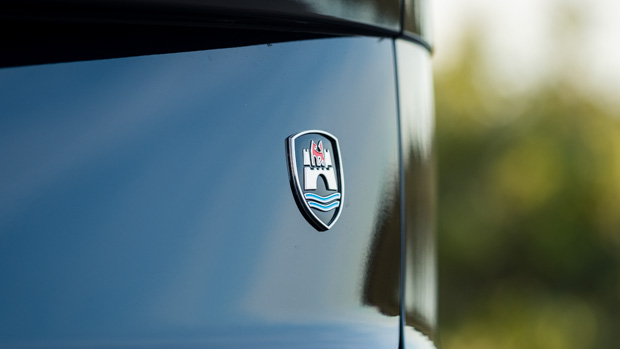
Instead of paying $3,618 for five years of maintenance, you can buy a package that costs $2,600 for the Touareg – it’s well worth it. Service intervals are relatively standard; you’ll need to stop by a workshop every 15,000km or 12 months.
Like all its cars, Volkswagen Australia backs the Touareg with a five-year, unlimited-kilometre warranty.
So is the Touareg, a vehicle with a Volkswagen badge on the front, really good enough to best the luxury names at their own game? Well, it depends on what kind of person you are.
Finished in ‘Moonlight Blue’ metallic – as our car was – the Touareg Wolfsburg doesn’t shout about its $119,990 list price. It’s pragmatic and tidy from the outside, though inside the obsessively neat interior, which confines many controls to the touchscreen, convolutes usability.
The buttoned-down and handsome styling is quite a contrast with the usual suspects with garish grilles, big chintzy alloy wheels and the like. However, we wish that Volkswagen had tried harder with the cabin fit and finish, as the creaking plastics brought down the Touareg’s perceived quality.
But this is an SUV that drives impeccably. When you need it to, the Touareg shrinks around and propels you down the road with that lump of grunt, any other time is as serene as you like. Couple that with a great stereo, heated, vented and massaging seats, and the Touareg is one of the better kilometre crushers out there.
Variant tested 210TDI WOLFSBURG EDITION
Key specs (as tested)
About Chasing cars
Chasing Cars reviews are 100% independent.
Because we are powered by Budget Direct Insurance, we don’t receive advertising or sales revenue from car manufacturers.
We’re truly independent – giving you Australia’s best car reviews.
The estimate provided does not take into account your personal circumstances but is intended to give a general indication of the cost of insurance, in order to obtain a complete quote, please visit www.budgetdirect.com.au. Estimate includes 15%^ online discount.
^Conditions Apply
Budget Direct Insurance arranged by Auto & General Services Pty Ltd ACN 003 617 909(AGS) AFSL 241 411, for and on behalf of the insurer, Auto & General Insurance Company Limited(ABN 42 111 586 353, AFSL 285 571).Because we don’t know your financial needs, we can’t advise you if this insurance will suit you. You should consider your needs and the Product Disclosure Statement before making a decision to buy insurance. Terms and conditions apply.
Indicative quote based on assumptions including postcode , 40 year old male with no offences, licence suspensions or claims in the last 5 years, a NCD Rating 1 and no younger drivers listed. White car, driven up to 10,000kms a year, unfinanced, with no modifications, factory options and/or non-standard accessories, private use only and garaged at night.
^Online Discounts Terms & Conditions
1. Discounts apply to the premium paid for a new Budget Direct Gold Comprehensive Car Insurance, Third Party Property Only or Third Party Property, Fire & Theft Insurance policy initiated online on or after 29 March 2017. Discounts do not apply to optional Roadside Assistance.
2. Discounts do not apply to any renewal offer of insurance.
3. Discounts only apply to the insurance portion of the premium. Discounts are applied before government charges, taxes, levies and fees, including instalment processing fees (as applicable). The full extent of discounts may therefore be impacted.
4. We reserve the right to change the offer without notice.